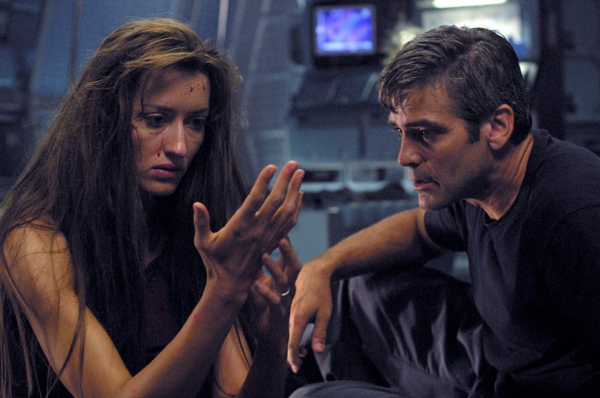Movie review by Greg Carlson
The great pleasure of Steven Soderbergh’s “Solaris” lies in the film’s identity as the most elliptical, thought-provoking, and enigmatic movie released by a major Hollywood studio this year. Few directors other than Soderbergh – who has cannily alternated his projects between narrative-fracturing, low-budget, poetic meditations like “The Limey” and big-name, big-budget, crowd-pleasers like “Ocean’s 11” and “Erin Brockovich” – could get away with such a ruminative, haunting, deliberately challenging piece. Soderbergh does it – with George Clooney in the leading role no less – and delivers in yet another genre previously untapped by the “Traffic” Oscar winner.
Based on a novel by Stanislaw Lem and previously made by Andrei Tarkovsky in 1972, “Solaris” bravely, gamely explores the limitations of human imagination, pushing well past the usual sci-fi questions about humankind’s place in the universe and the existence of a higher intelligence or deity. Clooney plays psychologist Chris Kelvin, a brooding, heartbroken, empty vessel of a man devastated by his beloved wife’s suicide. While attending to his own shattered life, Kelvin receives a message from an old friend indicating that something has “gone wrong” on the Prometheus space station that orbits the mysterious planet Solaris, a churning, volatile orb that changes colors like a chameleon.
Kelvin takes the mission, and upon his arrival at Prometheus, discovers that only two of the original crew continue to draw breath, and neither one seems able to offer much explanation of what recently happened. Understandably perplexed, if not downright shaken, Kelvin retreats to his quarters, and when he opens his eyes the following morning, he has been reunited with his wife – now very much alive. The planet Solaris, it seems, has created a doppelganger conjured up from everything that Kelvin knew about her. Played by Natascha McElhone, Rheya is a marvel both to Kelvin and to herself. In other words, the new incarnation of Rheya has free will, but negotiates her place in the world strictly out of Kelvin’s perceptions of the original – the new Rheya wants to kill herself, for example, but only because Kelvin remembers her as suicidal.
Like Hitchcock’s “Vertigo,” Solaris spends a great deal of its running time exploring the obsessions of a deluded protagonist who deeply misinterprets his own obsessive love for another person. Emotional catastrophe is inevitable in both films, but “Solaris” makes a worthy peer to Hitchcock’s masterpiece because Soderbergh’s handling of the content is sufficiently absorbing to transcend the outward quietness and stillness so despised by moviegoers who like their entertainment pre-digested, and with little room for imagination. “Solaris” might not be as personal to its director as “Vertigo” was to Hitchcock, but it is remarkable that both films were made by studios, and not independently produced.
“Solaris” is the kind of movie that relishes asking more questions than it answers, and by the conclusion, reality has been smeared into a blur – time seems to double back on itself and the audience is left to ponder whether there are more possible outcomes than the ones eventually reckoned by Kelvin. Some will certainly roll their eyes that Dylan Thomas’ line “and death shall have no dominion” forms a central thematic motif, but perhaps the key to the movie is contained within the poem. Soderbergh, however, is not interested in the definite (his own gorgeously meditative cinematography notwithstanding). The very first thing Rheya says to Kelvin when he makes her acquaintance is “Don’t blow it.” The line is funny – pure Soderbergh – but it is also filled with the idea that the possibilities of what could happen next are without limit.
